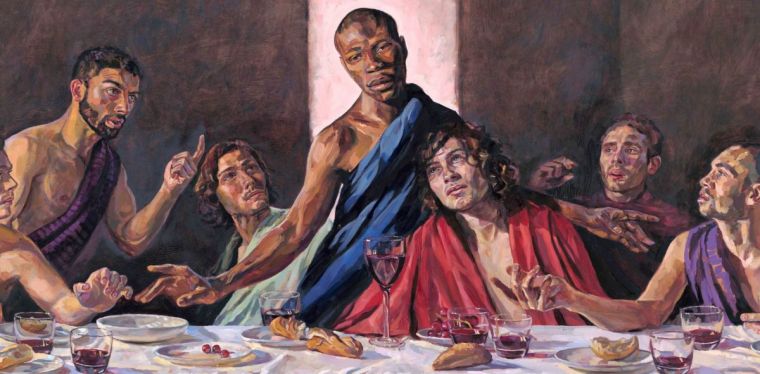Abbey's 'black Jesus' stirs up a storm – but is that so bad?

A large-scale painting of the Last Supper depicting Jesus as a black man has sparked controversy and heated debate in the UK and around the world.
I reckon that's no bad thing. In fact, it could be really positive.
St Albans Cathedral, 20 miles north of central London in leafy Hertfordshire, is installing the painting this weekend to "stand with the Black Lives Matter movement to be allies for change – building a strong, just and fair community where the dignity of every human being is honoured and celebrated, where black voices are heard, and where black lives matter."
The installation is a striking piece of art and it's provoking strong reactions – just as good art should do.
People are responding with a wide range of opinions. Many have welcomed the artwork, but others are outraged, accusing the Abbey of pandering to a 'political correctness' agenda. Some have described it as seeking to be 'trendy' and riding on the bandwagon of a popular movement.
Within St Albans itself, one local business owner posted: "I'm not religious, but I'm a big fan of St Albans Cathedral, its clergy and staff, and particularly the Dean, who I saw at the Black Lives Matter protest in St Albans and who's made a great and important statement with this art."
The Cathedral is a special place to me. I was ordained as a priest there, have served as a day chaplain at the historic building, and I minister at a parish church in the city.
Built on the site of an ancient shrine to Saint Alban, Britain's first Christian martyr, the Cathedral has been welcoming visitors for hundreds of years. It stands today as a thriving centre of worship, of community and of hospitality for thousands of pilgrims who visit the Cathedral each year.
The painting's artist, Lorna May Wadsworth, said: "I cast Jamaican-born Tafari Hinds as my Jesus to make people question the western myth that he had fair hair and blue eyes.
"I also knew that, from a previous portrait of Tafari, there is something in his countenance that people find deeply empathetic and moving, which is the overriding quality I wanted my Christ to embody."
Not everyone shares the artist's perspective. A Facebook post from the Abbey promoting the installation drew 400 comments within an hour, as people from around the world hotly argued the case for and against the artwork.
One person responded: "What a thought-evoking piece of art. I love it and cannot wait to come and view it. It saddens me that racism is so engrained in our society."
Another commented: "The church has not changed the colour of Jesus, they have decided to put on show a piece of art that happens to depict Jesus as black. Let's hope it just gives people a chance to question things they have always just accepted as being right."
Other comments were more critical, with a typical response, "More shameless pandering to Black Lives Matter, bringing trendy identity politics into what is supposed to be the traditional church."
Just this week, I heard a bishop describe the world as being in the grip of three pandemics: coronavirus, climate change and racism. We need to tackle all three if our planet is to survive and thrive.
People may object strongly to Lorna May Wadsworth's artwork, or they may welcome it. Either way, it provokes an important debate about the role of race in our society and how we have depicted Christ in western culture.
The Abbey has stirred up a storm, but maybe that's the only way for ingrained attitudes to be challenged, and new perspectives formed.
Rev Peter Crumpler is a Church of England priest in St Albans and a former Director of Communications for the CofE.











